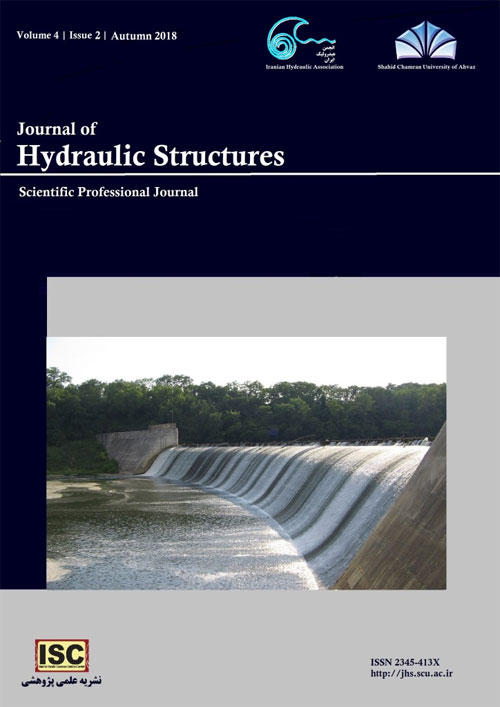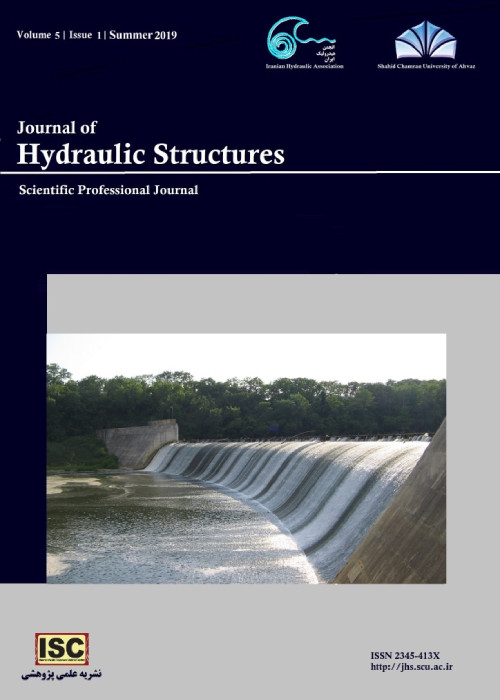فهرست مطالب

Journal of Hydraulic Structures
Volume:4 Issue: 2, Summer - Autumn 2018
- تاریخ انتشار: 1397/04/18
- تعداد عناوین: 6
-
-
Pages 1-9In this paper, the axisymmetric flow toward a pumping well has been numerically solved by the cell-centered finite volume method. The numerical model is descretized over unstructured and triangular-shaped grids which allows to simulate inhomogeneous and complex-shaped domains. Due to the non-orthogonality of the irregular grids, the multipoint flux approximation (MPFA) schemes are used to discretize the flux term. In this work, the diamond scheme as the MPFA method has been employed and the least square method is applied to express the full discrete form of the vertex-values of the hydraulic head. The scheme has been verified via the Theis solution, as a milestone in well hydraulics. The numerical results show the capability of the developed model in evaluating transient drawdown in the confined aquifers. The proposed numerical model leads to the stable and local conservative solutions contrary to the standard finite element methods. Also this numerical technique has the second order of accuracy.Keywords: Axisymmetric radial flow, Cell-centered finite volume method, MPFA method, Diamond scheme
-
Pages 10-16Slide gates are one of the most common gates used in hydraulic structures. These gates are often in practice hydraulically submerged. The usual method to determine the flow passes through the gate is solving simultaneously the energy and the momentum nonlinear equations by a numerical method. In this manuscript, a large number of various cases of gate sizes and flows are considered and solved numerically by using these two equations to obtain a database. This database is converted to dimensionless groups and then a direct relationship is developed by using three-dimensional curve fitting. The results obtained by the developed relationship is compared with those obtained by the numerical common method. The comparison results in a good agreement which indicates that the developed relationship is accurate and simple to be used in the design of slide gates.Keywords: Slide gate, Numerical method, Submerged gate, Curve fitting
-
Pages 17-26Lime is an effective substance to decrease the swelling of expansive soils. The effective use of lime as a stabilizing agent in the presence of sulfate under some circumstances has been questioned due to the formation of ettringite. In this research, the effect of the addition of rice husk ash (RHA) on the swelling pressure of a bentonite soil (B) modified with lime (L) and calcium sulfate or gypsum (G) was investigated. Nine groups of twin compacted samples, namely, bentonite soil (B), B + L (3% by dry weight), B+3%L+ 5%G, B+3%L+RHA (5, 10 and 15% by dry weight, respectively) and B+3%L+5%G+RHA (5,10 and 15%, respectively), were prepared and tested immediately for 1-D constant volume swelling pressure measurements. Similar groups of samples were prepared and tested after 7 and 28 days of curing. The results indicated the effect of RHA in decreasing the magnitude of swelling pressure in comparison with untreated and treated soil without RHAKeywords: Rice husk, Lime, Sulfate, Expansive soil, Swelling pressure
-
Pages 27-41In this paper, an efficient numerical model for solution of the two-dimensional unsteady dam-break problem is described. The model solves the shallow water equations through Characteristic-Based Split (CBS) finite element method. The formulation of the model is based upon the fractional time step technique primarily used in the finite difference method for the incompressible Navier-Stokes equations. In addition to well-known advantages of the finite element discretization in introducing complex geometries and making accurate results near the boundaries, the CBS utilizes interesting advantages. These include the ability of the method to simulate both compressible and incompressible flows using the same formulation. Improved stability of the CBS algorithm along with its capability to simulate both sub- and super-critical flows are other main advantages of the method. These useful advantages of the algorithm introduce the CBS as a unique procedure to solve fluid dynamics problems under various conditions. Since dam-break problem has principally a high non-linear nature, the model is verified firstly by modeling one-dimensional problems of dam-break and bore formation problems. Furthermore, application of the model to a two-dimensional hypothetical dam-break problem shows the robustness and efficiency of the procedure. Despite the high non-linearity nature of the solved problems, the computational results, compared with the analytical solutions and reported results of other numerical models, indicate the favorable performance of the used procedure in modeling the dam-break problems.Keywords: Characteristic-Based Split finite element, shallow water, dam-break, bore
-
Pages 42-58One of the principal criteria for development of the boundary element method (BEM) in porous media is derivation of the required fundamental solutions in the boundary integral equations (BIE). Furthermore, setting up the governing BIEs based on the governing partial differential equations (PDE) is another challenge in solving a physical phenomenon using BEM. In this regard, the governing BIEs for unsaturated porous media have been developed using the available derived fundamental solutions. In this research, a perturbation type approximation is exploited for developing a system of BIEs for the quasi-static unsaturated porous media with moderate variations in its properties. Nevertheless, the fundamental solutions of the medium with constant properties are applied. The method produces two sets of equations with constant parameters instead of the original equations. Besides, the required boundary conditions have been formulated. This type of BIEs is essential to be used in the BEM for unsaturated porous media as the fundamental solutions for a medium with coordinates dependent properties is not available so far. The resulted introduced BIEs may be used directly in a BEM numerical model for an unsaturated porous media in one, two or three dimensional conditions.Keywords: Unsaturated porous media, Boundary Integral Equation, Fundamental Solutions, Quasi-Static, Perturbation
-
Pages 59-79Monitoring the seepage, particularly the piezometric water level in the dams, is of special importance in hydraulic engineering. In the present study, piezometric water levels in three observation piezometers at the left bank of Jiroft Dam structure (located in Kerman province, Iran) were simulated using soft computing techniques and then compared using the measured data. For this purpose, the input data, including inflow, evaporation, reservoir water level, sluice gate outflow, outflow, dam total outflow, and piezometric water level, were used. Modeling was performed using multiple linear regression method as well as soft computing methods including regression decision tree, classification decision tree, and three types of artificial neural networks (with Levenberg-Marquardt, particle swarm optimization, PSO, and harmony search learning algorithms, HS). The results of the present study indicated no absolute superiority for any of the methods over others. For the first piezometer the ANN-PSO indicates better performance (correlation coefficient, R=0.990). For the second piezometer ANN-PSO shows better results with R=0.945. For the third piezometers MLR with R=0.945 and ANN-HS with R=0.949 indicate better performance than other methods. Furthermore, Mann-Whitney statistical analysis at confidence levels of 95% and 99% indicated no significant difference in terms of the performance of the applied models used in this study.Keywords: Data driven models, dam surveillance, soft computing, heuristic algorithms, dam engineering


